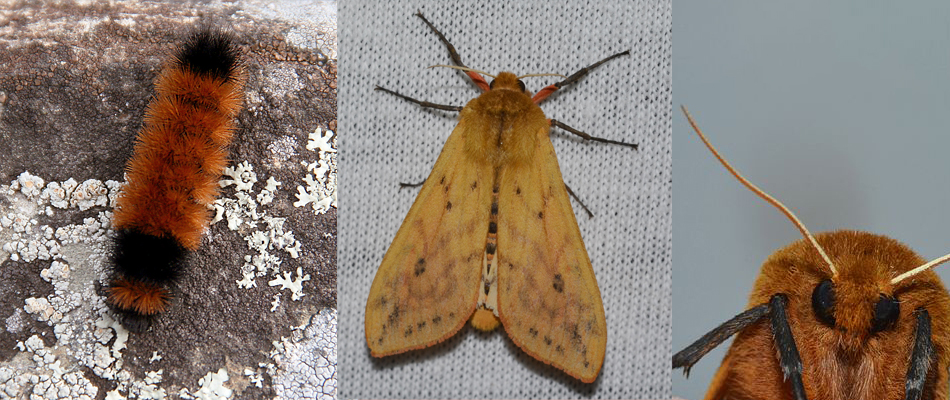The sun has come out, illuminating the soggy, white, crystalline world outside. The first snow is retreating, and in a bare patch of sidewalk, moving very slowly, is a little wooly bear caterpillar. They must be one of the hardiest insects and can be found moving around on mild days even in winter – apparently to upgrade their seasonal shelters.
Banded wooly bears, or wooly bears, or wooly worms are so familiar, wearing their fur coats of black and brown. Their hairs are stiff, and might be irritating to the most sensitive of us, although they are not poisonous. They eat a wide variety of leaves from several tree species as well as asters and can be found almost anywhere there is vegetation. They’ve also been know to be cannibals, but we won’t get into that.
Wooly bears are really the larvae of the Isabella tiger moth, Pyrrarctia isabella. The adults are beige-orange with a few spots, not a very noticeable moth at all. They produce two broods each year – the first in spring from the caterpillars that survived the winter. They then lay eggs to complete their life cycle in late summer. Those hatch into the wooly bears we see in the fall. These tough little caterpillars freeze solid in the winter, and their heart actually stops beating. They have enough stored energy to make it to warmer days when food is once again available.
The folklore surrounding the ability of the wooly bear to forecast the weather in the coming winter is interesting. It’s based on the width of the brown and black bands on the insect. The wider the brown band is, the milder the winter is expected to be. What happens, in fact, is that as the caterpillar matures, the brown band becomes longer. If the fall is long and mild, one might see more caterpillars with broad brown bands, but if there is an early onset to winter, it will force caterpillars with smaller brown and larger black bands to seek places to hibernate. We would certainly already be aware if that were the case. Another story is that if winter is to be severe, the wooly bears migrate south to escape the cold. The ability to predict the weather has no scientific basis, however.
If wooly bears are threatened, they either scurry off at a fast pace or curl up into a ball and play dead – allowing one to pick them up for a close look (unless you are sensitive to them). Even though they are common and constantly underfoot, they are interesting little creatures with 13 body segments, bristly hairs, and bright red-orange forelegs. Adult tiger moths are known to produce sounds which interfere with bat echolocation, and the larvae are known to take up and concentrate substances from plants which make them unpalatable to predators so they have the ability to defend themselves.
As far as insects go, wooly bears, or Isabella tiger moths, are probably more appealing to people than most. They are familiar, and share some of the same space with us, and probably survive despite some of the things we do. Although we are now bracing ourselves for the coming winter, they are the ones whose lives depend on the shelter they find in these last golden days of autumn.
photo- from iNaturalist.org, caterpillar and adult Isabella tiger moth

